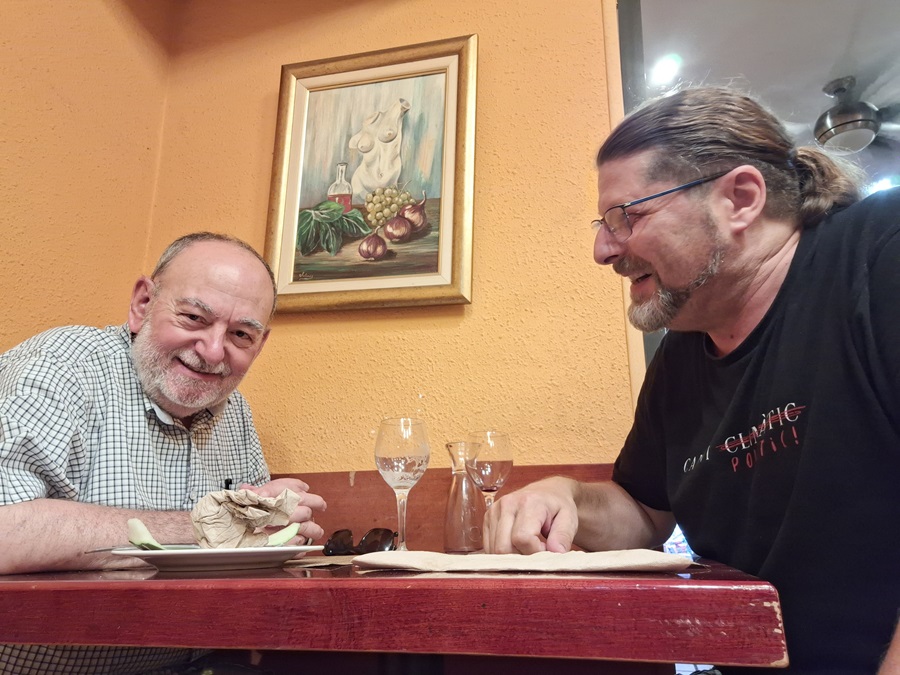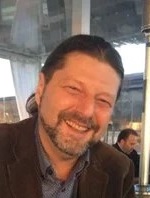- Face to face
- 4 de September de 2024
- No Comment
- 10 minutes read
Joaquim Pijoan: “Schizoid disorder turned my life upside down”

FACE TO FACE WITH…
Joaquim Pijoan, painter and writer. Sant Jordi Award
Joaquim Pijoan: “Schizoid disorder turned my life upside down”


He’s “Quim” and has been awarded the Sant Jordi Prize (2006) for Catalan literatura. We met a Sant Jordi afternoon signing books in Plaça Catalunya by the late nineties. The long moments of tranquility, with no queues of readers waiting for the books they had aquired to be signed, gave us great slow conversations, which arose that day between tears and hands on work. I don’t know exactly how it happened, but from then on, and every quarter, we share a meal and continue with our special get-together, where we don’t fix anything on the outside, but some things get fixed on the inside.

Joaquim Pijoan i Arbocer (Santa Cristina d’Aro, Baix Empordà, 1948) is a calm and convulsive painter and writer, certainly much calmer than convulsive. He writes every morning and paints every night, with some exceptions of course. His first published literary work was Somni (1983), his great leap to the general public. Winner of the Documenta Prize (1982), in 1987 he joined the group ‘Salt al Buit’, with Carles Piqueras, Antoni Cerdan and Pere Vilaldama, to carry out several exhibitions of painting and drawing. But since being a passionate reader, literature would burst into him again and thus he won the Sant Jordi Prize in 2006 with the narrative Sayonara Barcelona (2007). Then came next Amor a Venècia (2007), a novel to be savoured slowly, looking at the described stands where both the author and the protagonist walk side by side, an indecisive man who, faced with his past, sees the present as uncertain and the future even more so, and perhaps with the author showing up himself. He, a wandering sadness, lives disillusioned with everything and everyone. Joaquim describes us a journey that becomes a search for the essence of life, death and love.
Currently, Pijoan’s diaries are building an excellent trilogy that is coming up in the books Tempus Fugit (2016), El Jardí de les Delícies (2017) and finally, Retrat del Jove Skizo (2022). However, and despite his refined writing, that I consider to be Pla’s heir, as he recognised it, Joaquim has no restraints. Since 2015, he has been part of the ‘De Capçalera’ project, which aims to establish closer collaborations to strengthen the existing link between Catalan writers (with a consolidated prestige and career) and Catalan public libraries. Pijoan is linked to the Baldiri i Reixac Library in his hometown, Santa Cristina d’Aro. But the origin of his transition to literary creativity will not be found in this skeletal and outdated biographical introduction; on the contrary, you will see it by listening to his generous answers. He’s slow of speech, but determined of mind, and will satisfy you with his cinematic life, just like in Clint Eastwood’s latest films.
Your biography has always impressed me, Joaquim
My biography is extensive, in terms of time, 76 years, but very short in terms of studies. I only did primary and elementary school, in the decade of 1950-60. With the Certificate of Primary Studies, at the age of 14 you could already work, learning any trade, in agricultural work, for example, if you were from a peasant family.
Humble origins and virtually no previous training, but Sant Jordi prize for Catalan literature. How is this possible?
Let it be.
Let it be?
Many books at home and lots of readings.
When you were young you’d run one of the first supermarkets in Vall d’Aro?
Yes, my family owned a small business based on buying at 3 and selling at 4. And I came to be quite good in foreign languages at the times foreign tourism was just starting out.
And besides Catalan and Spanish, what else do you speak?
I speak half French, half English and half Italian.
And Japanese?
That’s my wife’s, she’s from there.
What caused a young son of shopkeepers to become a brilliant future writer?
By chance, this very pragmatic and elementary life was interrupted at the age of 25 by an unexpected serious mental disorder, which turned chronic and forced me to change my job, my surroundings and my way of life. The schizoid disorder turned my life upside down.
And how did the current writer come to be?
As a result of the illness I began to write a personal diary, recommended by the psychiatrists who diagnosed me and treated me with electroshocks. They also recommended aesthetic activities and outdoor life.
Any example?
I began to paint au plein air, to put it in French, turning my native Aro valley into an initiatory Barbizon. From there I jumped into the urban world, the big city was attractive to me, to receive a certain artistic training in order of filling some personal existential gaps in my life, and entering into an adventure, painting and literature, which still remains.
But how do you subdue the latent and lacerating schizophrenia within you?
Despite my advanced age, I must live with the side effects of the pharmacological treatment, neuroleptics and derivatives, and I must continue since I do not want to repeat the delusional crises of the early stages of that disorder. With time and good psychotherapy, I have managed to learn living with the illness and carry out what I believe it’s going to be my last literary work, the work of a lifetime, my SKIZO Diary, 1980-202?
What relationship would you think it connects your professional success with the education you received?
From my scant educational training, and the subsequent professional and existential evolution, illness first, artistic activities next, I would highlight the following points, which I believe are essential. A capacity for work achieved through dedication and effort from the earliest childhood.
And the Catholic religion?
It was the norm, either school and family environment were instilled of a religious faith wich is very difficult to be explained in a few words, which has gone through very different stages, from the initiation, learning by heart the catechism of these former times, to a mature faith, achieved through all kinds of heretical inputs, times of doubts and revelations, passing through the most radical and primary atheism, and on the edge of the suicidal abyss more than once.
Has the path of faith and knowledge been a long road to cultured atheism?
Well, maybe yes, but in my case, and because of the pathological causes exposed, it is not appropriate to venture what would have happened if instead of an education in the National-Catholicism of the time I had had the freedom of the current every man for himself. Speculating on these extremes would be like putting water in a basket.
What would happen today if you were a teenager?
From the conversations I have with the psychiatrists who continue to treat me, and who consider me a “successful patient,” today’s teenagers and young people have it harder, since some of them fall into what they call dual disorder. And here, the doctors themselves do not know if the illness leads them to drugs, or vice versa, the drugs are the cause of the mental disorder. I am not qualified to go into the details of this complex panorama.
Where do you think current education should change to improve knowledge and contrasted culture?
Perhaps, routine and memorization habits, repetitive, and a certain order in school life, perhaps excessive before, today missing, continued and reinforced in family life, I think that they would help many teenagers to find in the culture of effort, what the Japanese call ikigai, their reason for being in the world, and to live life with a certain harmony with themselves. And all this regardless of the worldly success or failure obtained.
It does not seem easy
However, we are in this world to try.
Source: educational EVIDENCE
Rights: Creative Commons

